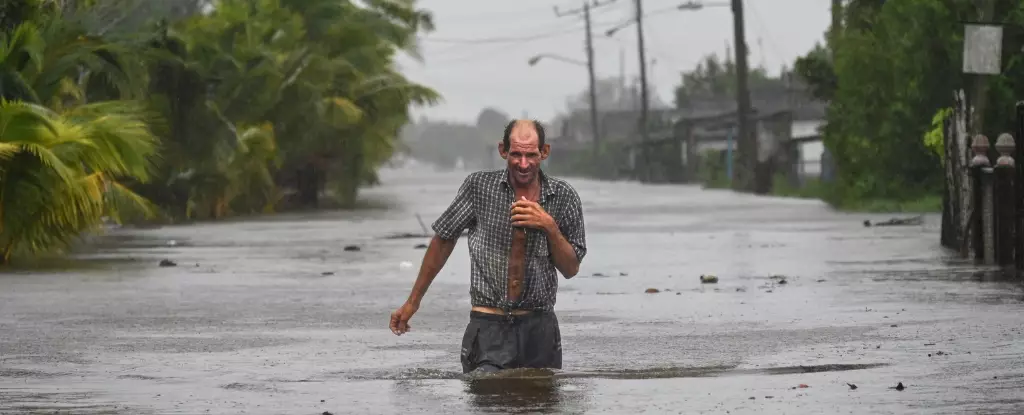Tropical cyclones, known variably as hurricanes or typhoons depending on their geographical location, are among nature’s most destructive forces. The data surrounding their immediate impact—structural damage, injuries, and deaths—often dominate media coverage and public discourse. However, recent research underscores a grim reality: the real toll of these storms extends far beyond the immediate aftermath, touching on long-term health and mortality in ways previously overlooked. As climate change intensifies these natural disasters, understanding and addressing their prolonged impacts has never been more urgent.
The Dire Immediate Impacts of Cyclones
In the wake of natural disasters like Typhoon Krathon, which is set to make landfall in Taiwan, or Hurricane Helene, already linked to the deaths of 155 individuals in the southeastern United States, the immediate consequences are striking. Local authorities document fatalities and injuries, painting a picture of lives lost and families shattered. However, the official toll often captures only a fleeting glimpse of the devastation. Hurricane John claimed 16 lives in Mexico last week, which while tragic, represents just a fraction of the broader tragedy after such storms pass.
Research has emerged revealing that the numbers recorded in the days and weeks following these storms represent only the tip of the iceberg when assessing human cost. A study examining 501 tropical cyclones impacting the continental US from 1930 to 2015 suggests fatalities can multiply astronomically, with indirect deaths—those occurring long after the storm—far surpassing immediate losses. Preliminary figures estimate that, when including these indirect fatalities, the toll per storm can range from 7,000 to 11,000 deaths, a staggering 300-fold increase compared to official counts.
The Long Shadow of Natural Disasters
This study challenges prevailing narratives about disaster resilience and recovery. It examines how the impacts of hurricanes resonate through communities long after the winds have calmed. Researchers describe the multifaceted effects of these storms: disrupted economies lead to poverty, infrastructure damage hampers recovery, pollution increases, and the stress of rebuilding can deplete mental health.
Interestingly, many affected individuals remain blind to their suffering’s correlation with previous storms. For instance, someone might pour their retirement savings into repairing hurricane damage only to find themselves financially crippled when medical costs arise later. Some individuals living in cyclone-affected areas often do not connect their deteriorated health to the incidence of past hurricanes. The study highlights that infants born years after a cyclone in affected regions face significantly higher risk factors for early mortality.
An unsettling dimension of the findings is the racial disparities in the death toll attributed to cyclones. Black individuals are disproportionately represented among the longer-term casualties, with the study noting that living in hurricane-affected regions contributes to 15.6 percent of all Black deaths from 1930 to 2015. This inequity highlights the systemic vulnerabilities that persist in historically marginalized communities that often lack resources for recovery.
Geographically, the toll also varies widely among states. In Florida, a state frequently inundated by hurricanes, 13 percent of all fatalities can be traced back to tropical cyclones. Other states like North Carolina (11 percent), South Carolina (nine percent), and Louisiana (eight percent) show similar patterns, revealing the need for tailored disaster preparedness strategies that account for regional experiences.
Climate Change and the Future of Cyclones
Compounding this already dire situation is the looming threat of climate change. As environmental patterns shift and alter the frequency and intensity of hurricanes, regions that historically have been less impacted may find themselves in the crosshairs of stronger storms. Researchers warn that states unaccustomed to these climatic shocks may suffer disproportionate death tolls due to their lack of preparedness and resilience.
Scientists advocate for enhanced support systems for communities at risk, emphasizing that mitigating the long-term impacts of cyclones necessitates deeper understanding and awareness. Only by acknowledging the full breadth of a cyclone’s impact—past, present, and future—can policies and responses be tailored effectively to safeguard vulnerable populations.
Understanding the long-term death toll of tropical cyclones calls for a paradigm shift in how society perceives disaster responses. It’s essential to look beyond immediate casualties and comprehend the holistic impacts of such natural disasters. Policies that support not only immediate relief efforts but also address long-term recovery are critical in fostering resilience in the face of ever-increasing climate-related challenges. By cultivating a greater awareness and taking proactive measures, communities can better prepare for the hidden, yet devastating, consequences of tropical cyclones, ensuring the longevity and health of their residents well into the future.


Leave a Reply